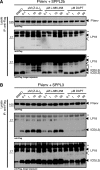Foamy virus envelope protein is a substrate for signal peptide peptidase-like 3 (SPPL3)
- PMID: 23132852
- PMCID: PMC3527927
- DOI: 10.1074/jbc.M112.371369
Foamy virus envelope protein is a substrate for signal peptide peptidase-like 3 (SPPL3)
Abstract
Signal peptide peptidase (SPP), its homologs, the SPP-like proteases SPPL2a/b/c and SPPL3, as well as presenilin, the catalytic subunit of the γ-secretase complex, are intramembrane-cleaving aspartyl proteases of the GxGD type. In this study, we identified the 18-kDa leader peptide (LP18) of the foamy virus envelope protein (FVenv) as a new substrate for intramembrane proteolysis by human SPPL3 and SPPL2a/b. In contrast to SPPL2a/b and γ-secretase, which require substrates with an ectodomain shorter than 60 amino acids for efficient intramembrane proteolysis, SPPL3 cleaves mutant FVenv lacking the proprotein convertase cleavage site necessary for the prior shedding. Moreover, the cleavage product of FVenv generated by SPPL3 serves as a new substrate for consecutive intramembrane cleavage by SPPL2a/b. Thus, human SPPL3 is the first GxGD-type aspartyl protease shown to be capable of acting like a sheddase, similar to members of the rhomboid family, which belong to the class of intramembrane-cleaving serine proteases.
Figures





Similar articles
-
Regulated intramembrane proteolysis of Bri2 (Itm2b) by ADAM10 and SPPL2a/SPPL2b.J Biol Chem. 2008 Jan 18;283(3):1644-1652. doi: 10.1074/jbc.M706661200. Epub 2007 Oct 25. J Biol Chem. 2008. PMID: 17965014
-
Substrate requirements for SPPL2b-dependent regulated intramembrane proteolysis.J Biol Chem. 2009 Feb 27;284(9):5662-70. doi: 10.1074/jbc.M807485200. Epub 2008 Dec 29. J Biol Chem. 2009. PMID: 19114711
-
The α-helical content of the transmembrane domain of the British dementia protein-2 (Bri2) determines its processing by signal peptide peptidase-like 2b (SPPL2b).J Biol Chem. 2012 Feb 10;287(7):5156-63. doi: 10.1074/jbc.M111.328104. Epub 2011 Dec 22. J Biol Chem. 2012. PMID: 22194595 Free PMC article.
-
Physiological functions of SPP/SPPL intramembrane proteases.Cell Mol Life Sci. 2020 Aug;77(15):2959-2979. doi: 10.1007/s00018-020-03470-6. Epub 2020 Feb 12. Cell Mol Life Sci. 2020. PMID: 32052089 Free PMC article. Review.
-
Mechanism, specificity, and physiology of signal peptide peptidase (SPP) and SPP-like proteases.Biochim Biophys Acta. 2013 Dec;1828(12):2828-39. doi: 10.1016/j.bbamem.2013.03.033. Biochim Biophys Acta. 2013. PMID: 24099004 Review.
Cited by
-
Signaling Functions of Intramembrane Aspartyl-Proteases.Front Cardiovasc Med. 2020 Dec 14;7:591787. doi: 10.3389/fcvm.2020.591787. eCollection 2020. Front Cardiovasc Med. 2020. PMID: 33381526 Free PMC article. Review.
-
N-terminome analyses underscore the prevalence of SPPL3-mediated intramembrane proteolysis among Golgi-resident enzymes and its role in Golgi enzyme secretion.Cell Mol Life Sci. 2022 Mar 13;79(3):185. doi: 10.1007/s00018-022-04163-y. Cell Mol Life Sci. 2022. PMID: 35279766 Free PMC article.
-
γ-Secretase inhibitors and modulators.Biochim Biophys Acta. 2013 Dec;1828(12):2898-907. doi: 10.1016/j.bbamem.2013.06.005. Epub 2013 Jun 17. Biochim Biophys Acta. 2013. PMID: 23791707 Free PMC article. Review.
-
Roles of regulated intramembrane proteolysis in virus infection and antiviral immunity.Biochim Biophys Acta. 2013 Dec;1828(12):2926-32. doi: 10.1016/j.bbamem.2013.05.005. Biochim Biophys Acta. 2013. PMID: 24099010 Free PMC article. Review.
-
The N-terminal PA domains of signal-peptide-peptidase-like 2 (SPPL2) proteases impact on TNFα cleavage.Commun Biol. 2025 Apr 30;8(1):686. doi: 10.1038/s42003-025-08102-y. Commun Biol. 2025. PMID: 40307375 Free PMC article.
References
Publication types
MeSH terms
Substances
LinkOut - more resources
Full Text Sources
Molecular Biology Databases
Miscellaneous

